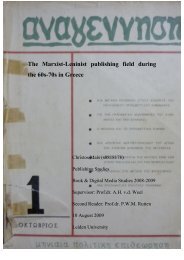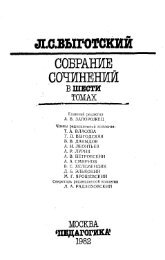Leon Trotsky: 1905
Leon Trotsky: 1905
Leon Trotsky: 1905
You also want an ePaper? Increase the reach of your titles
YUMPU automatically turns print PDFs into web optimized ePapers that Google loves.
<strong>Leon</strong> <strong>Trotsky</strong>: <strong>1905</strong>: CHAPTER 2-- Russian Capitalism<br />
Russia into the domain of the stock exchange.<br />
While economic contacts with Europe were still limited to the importation of craftsmen and machines or<br />
even to loans borrowed for productive purposes, this was, in the last analysis, a question of making the<br />
Russian national economy assimilate certain elements of European production. But when free foreign<br />
capital, in its race for a high level of profits, flung itself upon Russia's territory, protected by customs<br />
duties which were like the Great Wall of China, it became a matter of making the capitalist industrial<br />
organism of Europe assimilate the national economy of Russia. That is the program which has filled the<br />
last decades of Russia's economic history.<br />
Only 15 per cent of the total number of existing Russian industrial enterprises were created before 1861.<br />
Between 1861 and 1880, 23.5 per cent were created, and more than 6i per cent between 1881 and 1900,<br />
40 per cent of all existing enterprises having been created during the last decade of the nineteenth century<br />
alone.<br />
In 1767, 10 million pouds of pig iron were smelted in Russia. In 1866 (a hundred years later!) smelting<br />
still barely reached 19 million ponds. By 1896 it had already reached 98 million pouds, and in 1904, 180<br />
million; moreover, while in 1890 the south accounted for only one-fifth of the total amount smelted, ten<br />
years later it accounted for one-half. The development of the oil industry in the Caucasus proceeded at a<br />
similar rate. In the 1860s, less than a million pouds of oil were produced; in 1870 the figure was 21.5<br />
million pouds. Foreign capital entered upon the scene in the mid-eighties, taking possession of<br />
Trans-caucasia from Baku to Batum and launching operations intended for the world market. By 1890 oil<br />
production had risen to 242.9 million ponds, and by 1896 to 429.9 million pouds.<br />
Thus we see that the railway, coal-mining and oil industries of the southern part of the country, to which<br />
the economic center of gravity has been shifting with extreme rapidity, are only twenty or thirty years<br />
old. In this part of Russia, the development assumed from the very start a purely American character,<br />
and, within a very few years, Franco-Belgian capital has radically changed the appearance of the steppe<br />
provinces, covering them with giant enterprises of a size almost unknown in Western Europe.<br />
Two conditions were necessary for this: European/American technology and the Russian state budget.<br />
All the metallurgical plants of the south -- many of which were bought from America, down to the last<br />
bolt and screw, and transported across the ocean -- had government orders guaranteed for several years<br />
ahead at the moment of going into operation. The Urals, with their patriarchal, semi-feudal traditions and<br />
"national" capitals, remained a long way behind and it is only recently that British capital has begun to<br />
eradicate barbaric "Russianness" in that part of the country as well.<br />
The historical conditions of the development of Russian industry sufficiently explain the fact that, despite<br />
its relative youth, neither small-scale nor medium-scale production plays any significant role within it.<br />
Large-scale factory and plant production has not grown in Russia in any "natural" or organic manner. It<br />
did not grow gradually out of artisanal trade and manufacture, since artisanal trade itself had no time to<br />
grow out of the cottage industries and was doomed to economic death, even before its birth, by foreign<br />
capital and foreign technology. The cotton mill had no need to fight the craftsman weaver; on the<br />
contrary, it was the cotton mill that gave birth to cotton-producing cottage industries in the villages.<br />
Likewise, the ironmaking industry of the south and the oil industry of the Caucasus were not obliged to<br />
swallow up any small enterprises; on the contrary, such enterprises had to be brotight into existence as a<br />
series of secondary and ancillary branches of the economy.<br />
http://www.marxists.org/archive/trotsky/works/<strong>1905</strong>/ch02.htm (4 of 8) [06/06/2002 13:41:32]















![tyf Enf=O=n]lgg](https://img.yumpu.com/47584932/1/190x245/tyf-enfonlgg.jpg?quality=85)

